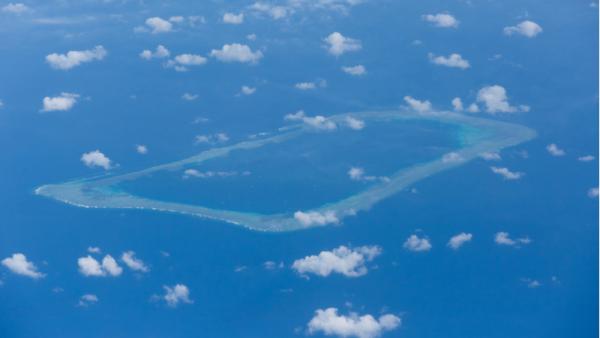Philippine foreign policy in an era of great power contestation
Hlib Shabashnyi / Shutterstock

Elena Collinson, Senior Project and Research Officer, Australia-China Relations Institute, University of Technology Sydney |
This article appeared in the Australian Institute for International Affairs’ blog Australian Outlook on December 27 2018.
‘A rainbow after the rain’, enthused President Xi Jinping, describing his perception of the state of Philippines-China relations in an article he penned prior to his November 20-21 state visit to Manila.
Xi’s visit, the first in 13 years by a Chinese head of state, was capped with a joint statement with Philippine President Rodrigo Duterte elevating the bilateral relationship to one of ‘comprehensive strategic cooperation’. Altogether, 29 agreements were signed, including a memorandum of understanding on oil and gas exploration in the South China Sea (SCS) and another on the Belt and Road Initiative.
Since assuming office in June 2016, Duterte has swung his foreign policy vis-a-vis China fully away that of from his predecessor Benigno Aquino III’s defiance towards China’s expansive territorial claims in the SCS. Instead of asserting the Permanent Court of Arbitration’s (PCA) ruling invalidating Chinese claims of sovereignty in the SCS, Duterte has chosen to take a conciliatory approach with his neighbour, due in large part to keen interest in contributions China could make to his centrepiece US$180 billion dollar ‘Build, Build, Build’ infrastructure program. Already, he has set the record of having visited China the most number of times among any sitting Philippine president in their early years in office.
Duterte reportedly reassured Vietnam’s prime minister on April 27 that the PCA’s decision would be addressed ‘in due time’. He had, however, just the day before placed the blame squarely on the US for China’s militarisation and land reclamation in the SCS saying ‘only America’ could have halted China’s expansionism but they ‘did nothing’.
Duterte’s embrace of a so-called ‘independent foreign policy’, signals a shift away from the Philippines’ erstwhile unabashed affinity and alliance with the United States. This appears to be borne as much from his own assessment of which country could do better for the Philippines’ immediate national interests as from his opposition to the sentiment from William Howard Taft’s time, that the country is America’s ‘little brown brother’, as well as from his prior personal experiences with US authorities. He has justified his stance by citing past historical atrocities committed by the US during the colonisation period. It is not coincidental that the United States recently decided to return the Balangiga Bells to the country in a gesture of putting paid to a long-festering national grievance.
China’s charm offensive in the Philippines is a recognition of the country’s strategic importance. On November 26 it was reported that the Manila Trench had been marked out as a potential site in China’s plans for an ‘AI Atlantis’, a first of a kind underwater base overtly for conducting scientific research but which could also be used for security and defence operations. A former chief of the Philippine Armed Forces Intelligence Services notes the critical location of the Manila Trench: it ‘is the only portion of the South China Sea that is deep enough where US nuclear attack submarines can approach surreptitiously and launch a first strike against China’s east coast’.
But despite the Philippine President’s efforts at closer convergence with China and not withstanding his popularity, a significant trust deficit on China remains amongst the Filipino public. The Social Weather Stations’ (SWS) third quarter survey for 2018 showed the net trust rating for China was ‘poor’ at -16. Positive trust ratings for China have only been recorded nine times out of 47 surveys since 1994, with the highest rating achieved being ‘moderate’. The US, on the other hand, scored a ‘very good’ net trust rating at +59, with net trust consistently positive since 1994. Pointedly, another SWS survey showed that 84 percent of Filipinos are critical of the Duterte administration’s inaction on China’s activities in the SCS.
There is little appetite among Filipinos for the dislodgement of the US as the world’s dominant power. In October, a Pew survey showed 77 percent of Filipinos preferred the US as the world leader, compared with 12 percent preferring China.
Government opposition has positioned itself against Duterte’s unbridled push to strengthen ties with China, expressing wariness of Chinese influence and intentions. For example, minority senators in July sought an inquiry into a government plan to air Tagalog-dubbed Chinese TV shows on state TV, stating that it ‘poses a danger of spreading Chinese propaganda’.
Frayed ties with the US seem to be slowly on the mend due in significant part to the Philippine defence establishment’s unwavering commitment to the alliance. The pronouncement that the Philippines would ‘separate‘ from the US, made during the first months of Duterte’s presidency, has not eventuated.
In fact, on April 17, construction began on a US-funded facility in Cesar Basa Air Base in Pampanga, a project under the Enhanced Defense Cooperation Agreement (EDCA) signed in 2014. EDCA has been described as ‘the most significant defense agreement [the US has] concluded with the Philippines in decades’ – one that Duterte had threatened to tear up in 2016. Although Duterte had placed limits on the annual Balikatan joint military exercises involving the army, navy and air force last year, the exercises were scaled up again this year.
A joint statement issued out of a meeting between US President Donald Trump and Duterte on November 13 2017 ‘reaffirmed‘ their commitment to the 1951 Mutual Defense Treaty. And on October 26 this year Defense Secretary Delfin Lorenzana told his US counterpart Jim Mattis that the alliance ‘remains robust‘. He is also said to have told US leaders that ‘while the Philippines has revitalised defense partnerships and is exploring new ones’ that this ‘does not in any way affect’ the alliance.
For all of Duterte’s rhetorical flourishes, institutional checks and the influence of other key stakeholders, including portions of the political establishment, the defence establishment and, most importantly, the broader population have moderated the administration’s swing towards China. Should infrastructure investment pledges fail to materialise and as China continues unwelcome actions in the SCS, this opposition will gain traction.
The mid-term elections next year will be an important indicator of the national mood.
Author
Elena Collinson is Senior Project and Research Officer at the Australia-China Relations Institute at the University of Technology Sydney.

